Abstract
Rising global concerns about global warming caused by pollution from excessive fossil fuels consumption, along with the high price of them in diesel engines, are the important reasons to search for fuels which is readily available and do not have destructive effects on the environment. Biodiesel is arguably the most appropriate and sustainable alternative to diesel fuel. Tomato seeds are one of the potential sources of biodiesel. They make up about 72% by weight of tomato waste, which contains an average of 24% oil. Tomato seed oil (TSO) can be used as a cheap and non-edible source of biodiesel. This paper investigated, both experimentally and numerically, the effects of different diesel–TSOB (tomato seed oil biodiesel) blends on the performance and emissions parameters of a four-cylinder, four-stroke, indirect injection diesel engine. The main goal of the paper was the simulation of the formation process of the emissions in the combustion chamber. The experimentally measured parameters such as torque, brake specific fuel consumption, exhaust gas temperature, nitrogen oxides, carbon monoxide, carbon dioxide, particulate matter, peak in-cylinder pressure, in-cylinder temperature and Reaction_Progress_Variable at different engine loads and speeds from 1200 to 2400 rpm at increments of 200 rpm are analyzed through ANOVA. The highest brake specific fuel consumption (BSFC) was observed for pure diesel and the lowest for the fuel blend with 10% biodiesel. The fuel blend with 20% biodiesel produced the highest torque. The engine was modeled using the AVL FIRE software. The model simulation results revealed that the highest nitrogen oxide (NOx) is produced in the throat of the combustion chamber to the top of the piston, the place of carbon dioxides (CO2) formation is near the combustion chamber boundaries and the location of carbon monoxides (CO) formation is near the combustion chamber boundaries and at the center area of the top of the piston. These results also show that the particulate matter (PM) emissions are formed where the fuel is injected into the combustion chamber.
1. Introduction
The world has been facing several environmental and energy challenges caused by the ever-increasing global industrialization and population growth. The twenty-first century has enhanced our awareness of environmental pollution, knowledge of the energy resources and depletion of fossil fuel sources, the oil price fluctuations and other related issues. Searching for alternative fuels from renewable resources for daily use has become a challenge. In a world that is full of competition, improvements in engine performance are of great importance for automotive manufacturers. Much research is being done on the combustion process in the combustion chamber to increase engine efficiency. These researches are done in two ways: one is experimental research and the other is numerical simulations such as computational fluid dynamics (CFD) that are widely used. Biodiesel consists of long-chain fatty acid esters. It could be derived from animals or plants. It contributes to the protection of the climate, the soil and water resources, while not producing large amounts of greenhouse gas emissions [1].
Due to the above-mentioned reasons, most countries that are dependent on fossil fuels are seeking alternative fuel sources. Biodiesel, which has the general chemical formula of 19H35COOCH3, and diesel, due to the similarity of their chemical structures, can be mixed with each other at any percentage [2]. The amount of oxygen in the chemical structures of biodiesel and diesel is very varied. There is 1% oxygen in diesel [3]. Ten to twelve percent of the weight of biodiesel, however, is oxygen. This allows a more complete combustion, reduces energy density and reduces suspended particulate matter emissions, making it a cleaner fuel. Compared with diesel, biodiesel has a higher flash point, density, viscosity and cetane number, and it has a lower heating value (LHV) [4,5].
One of the main causes of air pollution and emissions is the consumption of about one-third of fossil fuels in internal combustion engines. Biodiesel can be used as a clean fuel to reduce exhaust emissions such as sulfur dioxide, carbon monoxide, carbon dioxide and unburned hydrocarbons [6]. In 2015, it was found that tomato seed can be used for producing biodiesel. Since it contains an average of 24% oil, it cannot be used directly because of the high acidity [7,8]. Almost 188 million tons of fresh tomatoes, on a global scale, was produced annually in 2018 [9]. Nevertheless, the linked factories of the greatest brands of global food industries process 40 million tons of tomatoes annually [10]. Tomato processing industries are patchily scattered around the world (Figure 1). In these industries, tomato waste contains skin and seed which constitute a problem for disposal [8]. About 72% of the weight of tomato waste consists of tomato seed, which is inedible for humans and used as animal feed or as fertilizer [11,12].

Figure 1.
Global tomato processing in 2018 [9].
Harish et al. [13] tested a biodiesel extracted from tomato seed in a single-cylinder Compression Ignition (CI) engine. They experimentally evaluated the level of emissions and engine performance at a 1500 rpm stable speed of the engine. Karami et al. [6] derived biodiesel fuel from the oil of tomato seed. They experimented and simulated the emissions of a one-cylinder Lombardini engine, using an artificial neural network (ANN). Karami et al. [6] developed a model of a back propagation neural network with the configuration of 3–10–5 (number of input layer–hidden layer–output layer neurons) for predicting engine emissions of CO2, O2, CO, NOx and HC. Karami et al. [14] surveyed the performance of the one-cylinder Lombardini engine fueled by TSOB. They experimented and simulated its performance using ANN. Experimental evaluation can provide valuable and basic information, but the disadvantages of this method are the need for expensive equipment and a lot of time to perform tests. The simulation of multi-dimensional computational fluid dynamics (CFD) codes is another method that has been considered in recent years to study engine combustion. The CFD method works by solving the equations that rule the flow and transfer species in the combustion process to obtain a knowledge about the flow arena in the combustion chamber [15,16].
Barzegar et al. [17] evaluated the emissions formation and the combustion process of a Lister 8.1 IDI diesel engine. The simulation showed that when full load is not applied to the engine, most of the fuel is burned in the chamber on top of the piston, while when the engine is worked at full load, the amounts of fuel burned in the main combustion chamber and pre-combustion chamber are equal. Harch et al. [18] developed a combustion model using CFD software and the AVL FIRE program to predict the performance and emissions specifications of a diesel engine for a second-generation biodiesel at various compression ratios and injection timings of the engine. The results of the computational modelling displayed that B5, as compared with diesel, improved slightly the engine efficiency and performance, while, modestly, emissions were reduced. On the other hand, compared with diesel, B10 bettered the efficiency and performance of the engine and its emissions were significantly reduced. Combustion in diesel engines has some drawbacks such as the formation of emissions and how and when its production occurs in the cylinder [19,20,21]. Computer simulation can easily identify combustion structures, though very expensive equipment is required to do this with experimental research. Furthermore, knowing exactly what happens at each degree of crankshaft rotation during the combustion process can reveal information of the pollutants that are produced, the measurement of which could be almost impossible by devices [22]. The engines with the main and pre-combustion chambers, mass and energy are constantly exchanged between the two combustion chambers, which complicates the nature of indirect injection engines, so this research tries to discover the quality of combustion in these types of engines. Another purpose of this paper is to discover the correlation between the geometry of the combustion chamber and combustion quality as well as the emissions production. If the performed studies on combustion engines are examined, it can be seen that a small number of them have evaluated the modelling of combustion in the indirect combustion diesel engines.
This research’s objective is to propound a CFD simulation. For this purpose, the AVL FIRE software has been used for predicting and evaluating the combustion process, performance parameters, flow field, emissions and component wear in a four-cylinder Kubota V3300 indirect injection diesel engine fueled with various D-TSOB second generation biodiesels. This was aimed at boosting the quality of engine performance while reducing the emissions at different loads and speeds of the engine. In presenting a computational simulation, without comprehensive testing and the spending of too much time and money, we aimed at predicting the effects of the engine’s input parameters such as different speeds and loads of engine and diverse fuel blends on the combustion, performance and emissions at any hypothetical condition that could affect the engine. In this work, the performance of a diesel engine and the parameters in relation to emissions of four diesel–TSOB mixtures at five loads and seven engine speeds were evaluated. This investigation was done empirically at a total of 140 different engine conditions. Furthermore, the blends of deasil–TSOB as an alternative fuel for potential use in CI engines were examined, evaluated and modelled. The combustion chamber of the engine was designed by the CATIA software and then imported to the AVL FIRE software. In the available literature, this subject has not been tested with any type of four-cylinder engine as yet but is addressed in this paper. There are many advantages to the thermodynamic simulation of engine combustion. For instance, not only can these models be used to increase the fuel efficiency, but they can also be used to develop the technology of internal combustion engines and greatly reduce their emissions. These models can also be a valuable guide for engine-maker industries and biodiesel manufacturers.
2. Material and Methods
2.1. Biodiesel Fuel
In the present study, biodiesel extracted from tomato seed oil was used. To produce the TSOB, the transesterification method was used. In this method, the TSO was heated near a catalyst and acid. The physical and combustion properties of diesel [23] and TSOB based on relevant ASTM standards are listed in Table 1. The engine was fueled and tested with diverse volume percentages of the biodiesel/diesel mixtures, which included 0% (B0), 5% (B5), 10% (B10) and 20% (B20) of TSOB. For each test, 15 L of fuel mixture was prepared. For example, for B10, 13.5 L of diesel (90%) and 1.5 L of TSOB (10%) were mixed together. Each of the D-TSOB blends were used separately at 0%, 25%, 50%, 75% and 100% of full load of the engine and for speeds from 1200 to 2400 rpm at increments of 200 rpm. The ISO 8178 standard engine test procedure was used to do linked tests for engine emissions and performance, and these were based on short-term tests by a full factorial experiment based on the complete randomized block design. In this study, each experiment was performed with four repetitions.

Table 1.
Specifications of diesel and tomato seed oil biodiesel (TSOB) in accordance with ASTM standards.
2.2. Experimental Set-Up and Procedures
In this study, the four-cylinder indirect injection engine IDI Kubota V3300, the specifications of which are shown in Table 2, was used for the experimental study of biodiesels. The engine’s combustion chambers were also simulated [24]. The combustion systems of these engines are unique in that they have a three-valve construction, made up of two air intake and one exhaust valve per cylinder which improve the air intake rate over that of conventional E-TVCS (Three Vortex Combustion System) engines. By this construction, it is possible to package a large displacement engine more compactly, see Figure 2a [25]. The engine, which was coupled to the low-inertia and water-cooled GW63 eddy-current dynamometer, was able to measure the operation for testing engines at up to 63 kW, 250 ± 0.04 FS Nm and 9000 ± 1 rpm. The location of these machines is the thermodynamics laboratory of Central Queensland University (Australia). The Dina Engine fuel consumption measurement system with an accuracy of ±0.001 kg was used to measure fuel consumption and the MAHA-MGT5 device, whose technical specifications are shown in Table 3, measured the emissions of the engine. In addition, the exhaust gases temperature data in terms of Kelvin was automatically recorded on the computer by an AVL DISMOKE 480 BT device with accuracy of ±5 K. This machine can determine CO, CO2, and HC values using infra-red technology, and also the amounts of O2 and NOx gases using chemical sensors. A schematic of the set-up of these devices is shown in Figure 2b.

Table 2.
Engine specifications of Kubota V3300.
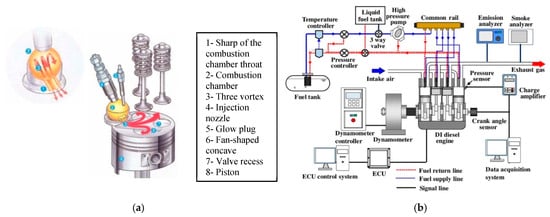
Figure 2.
(a) Kubota V3300 combustion system [25]; (b) schematic of engine and dynamometer.

Table 3.
MAHA-MGT5 machine specifications.
2.3. Engine Combustion Simulation by AVL FIRE Developed Model
To predict CI engine emissions and performance, an engine simulation model, which in our study was developed using AVL FIRE, can be used. To analyze the manifolds and intake ports, combustion, cooling jackets, etc., AVL FIRE, which is a 3D CFD simulation software, can be used. Experts are able to perform, analyze and set-up the process of combustion and injection in the CI engines using the Engine Simulation Environment (ESE) Diesel that is a CFD simulation tool [17]. This software is a multidimensional CFD modeling code which is employed in simulating the fluid flow, fuel spray and engine combustion process. The code is capable of solving the average conservation equations of total mixture mass, enthalpy, species and momentum [26]. In the current study, for turbulence modeling, a compressible version of a standard two equations k-ζ-f turbulence model was used, which was developed by Hanjalic et al. [27]. A version of a model of eddy-viscosity according to the elliptic relaxation concept of Durbin was proposed by those authors. The aim is to improve the numerical stability of the original v2−f model by solving a transport equation for the velocity scale ratio ζ = v2/k instead of the velocity scale v2. The primary atomization of spray droplets was simulated using the Kelvin–Helmholtz model and Rayleigh–Taylor (KH–RT) breakup model employed for modelling the secondary atomization of spray droplets. In addition, to model the evaporation of droplets and heat-up, the model of Dukowicz was utilized [28]. The simulation is carried out only during the closed cycle (i.e., in part of the compression stage, all of the combustion stage and part of the expansion stage). Accordingly, analyses are provided only qualitatively. In this technique of modeling, the combustion chamber of the IDI Kubota V3300 diesel engine was developed in CATIA and then imported to the AVL FIRE software. The combustion process was simulated for various different engine situations. The simulation includes the details of fuel spill combustion, fuel mix, maximum cylinder temperature and distributed simulation that can simulate the combustion process. It also simulates the collision of the fuel spray fountain with the wall and air circulation inside the cylinder and their interactions, the formation of emissions and other flow settings. The input and output parameters of the simulation are listed in Table 4.

Table 4.
Parameters of simulation.
To reduce the calculation time of combustion modeling, the intake stroke calculation is usually not carried out which means the start of calculation is at the inlet valve closure. In order to reduce the effort for mesh generation, a simplified geometry was used. For instance, ports and valves linked to cylinder intake (valve reliefs) were ignored (see Figure 3 and Figure 4). In the symmetrical combustion chamber, as much as possible, and if the fuel injection mass from the injector holes is the same, a symmetrical segment from the combustion chamber, which contains only one of the injector holes, can be meshed. The segment angle is obtained by dividing the angle of the circle (360°) by the number of nozzle holes. In order to place the fuel injection hole not along cell faces but within a cell layer, an uneven number of subdivisions is a good recommendation. For example, for a segment with an angle of 45 degrees, it should be better to choose a subdivision, in the polar direction, of about 17 cell layers.
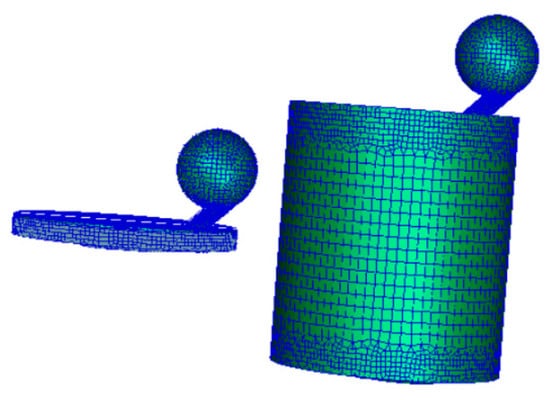
Figure 3.
Engine computational grid in Top Dead Centre (TDC) and Bottom Dead Centre (BDC) positions.

Figure 4.
Modeling the mesh of sloping surfaces on top of the piston head.
3. Results and Discussion
The mean values of the measured parameters regarding the engine were analyzed in 140 groups of tests in homogeneous subsets. The engine speed of 1400 rpm was proposed to investigate, since the results that correspond to the performance curves of the Kubota V3300 engine in the workshop manual show that the peak of torque occurs at 1400 rpm [29]. The analyses were carried out using the test of post hoc Duncan multi-domain using the SPSS software. In this test, the differences among the averages of variables of all engine working conditions are shown, at the level of 0.05, by different letters (refer to Figure 5, Figure 6, Figure 7, Figure 8, Figure 9, Figure 10 and Figure 11 with index (b)).
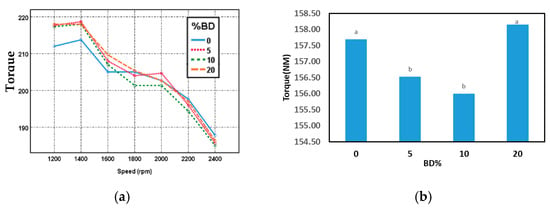
Figure 5.
(a) T vs. S at 100% load; (b) mean values of total data of T for different speeds and loads. The letters a–d inside the diagram indicate significant differences (P ≤ 0.05).
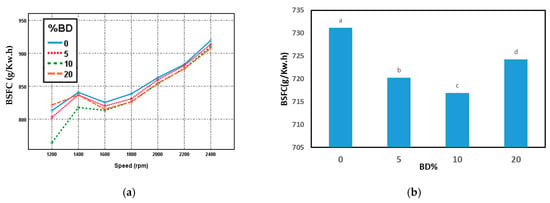
Figure 6.
(a) Brake specific fuel consumption (BSFC) vs. S at 100% load; (b) mean values of total data of BSFC for different speeds and loads. The letters a-d inside the diagram indicate significant differences (P ≤ 0.05).
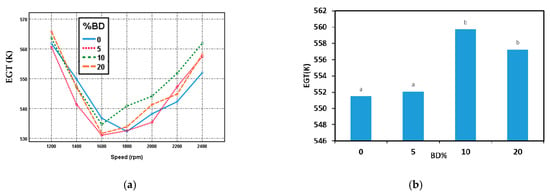
Figure 7.
(a) EGT vs. S at 100% load; (b) mean values of total data of EGT for different speeds and loads. The letters a-d inside the diagram indicate significant differences (P ≤ 0.05).
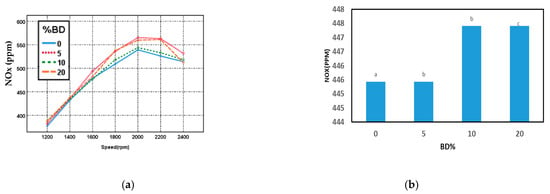
Figure 8.
(a) NOx vs. S at 100% load; (b) mean values of total data of NOx for different speeds and loads. The letters a-d inside the diagram indicate significant differences (P ≤ 0.05).
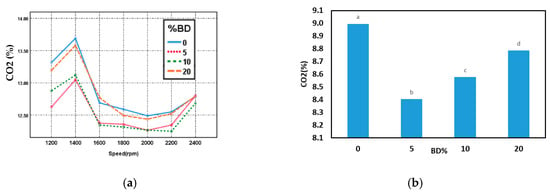
Figure 9.
(a) CO2 vs. S at 100% load; (b) mean values of total data of CO2 for different speeds and loads. The letters a-d inside the diagram indicate significant differences (P ≤ 0.05).

Figure 10.
(a) CO vs. S at 100% load; (b) mean values of total data of CO for different speeds and loads. The letters a-d inside the diagrams indicate significant differences (P ≤ 0.05).
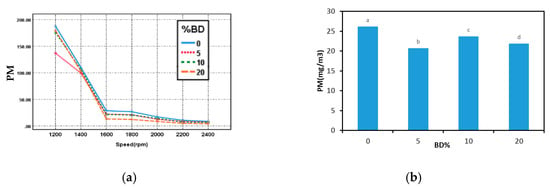
Figure 11.
(a) Particulate matter (PM) vs. S at 100% load; (b) mean values of total data of PM for different speeds and loads. The letters a-d inside the diagram indicate significant differences (P ≤ 0.05).
3.1. ANOVA using Post Hoc Duncan Multi-Domain Test
3.1.1. Performance
Figure 5a indicates the trend of torque at 100% load according to variations in engine speed for each different blend. The lowest and highest torques occurred at 2400 and 1400 rpm, respectively. At 2400 rpm, there is not enough time for air intake and the subsequent raising of the cylinder pressure. As a result, the combustion pressure is reduced, and the static inertia of the movable components increases. Therefore, at 2400 rpm, the engine produces torque lower than the expected value [30,31]. The Duncan test shows that an increase in biodiesel percentage up to B10 makes the engine torque drop by about 5–10% due to the lower LHV of the biodiesel [32]. However, B20 produced the highest torque at about 158 Nm as shown in Figure 5b. The reason is the higher content of oxygen, density and biodiesel consumption [33].
Figure 6a points out that by increasing the speed to 100% full load, the trend of brake specific fuel consumption (BSFC) rises incrementally. However, a relative peak can be seen at 1400 rpm. Since the highest torque is produced at this rpm, it seems that SFC is relatively higher at 1400 rpm [34]. Due to the need for a higher engine power, the BSFC generally, with increments in engine speed, increases. According to Figure 6b, the fuels of B0 and B10 have the highest and lowest SFC, respectively; therefore, the difference between them is eight percent. Due to the fact that the density of TSOB is higher than that of diesel (refer to Table 1), for an equal volume of diesel and biodiesel, the higher density of biodiesel and its mass flow allows more fuel to be injected into the combustion chamber. In addition to these parameters, since more viscosity causes less atomization as well as injection pressure and TSOB has the higher viscosity than that of diesel (refer to Table 1), considerations should also be given into the atomization ratio, the injection pressure and viscosity because they affect the brake power values and BSFC [33,35]. One of the properties that affect BSFC is the cetane number. An increase in the cetane number results in a reduction in ignition delay time, which in turn improves combustion and reduces fuel consumption [36].
Figure 7a shows that the enhancement of engine speed at 100% load varies the EGT of all the blends with a similar trend. This means that, as the rpm is increased up to 1600 rpm, EGT declines by around 5% before rising again. The reason is that EGT is affected by the quality of fuel combustion. To moderately improve the fuel properties and combustion quality, the biodiesel and diesel are mixed. The effects of the cetane index and fuel viscosity on combustion delay are opposite effects. In such a way that the higher the viscosity, the higher the combustion delay; the higher the cetane index, the lower the combustion delay. Therefore, after injection of the fuel at low engine speeds, for combustion in the pre-mixed phase, the low volume of fuel will be prepared. If the pressure inside the cylinder decreases slightly, the initial burnt gases temperature also reduces slightly. However, as the engine speeds up, the ignition delay also increases, but this process will be reversed when the combustion temperature and EGT are increased [37]. Figure 7b indicates that if the percentage of biodiesel increases in the fuel blends, the EGT of around 551 K for B0 and B5 increases up to 560 K for B10, before decreasing in the case of B20 to almost 557 K. The increase in EGT for B10 is due to an increase in in-cylinder pressure caused by some biodiesel properties, but with a higher increment in the percentage of biodiesel, the in-cylinder pressure and the EGT are increased [14].
3.1.2. Emissions
Figure 8a shows that an increment in engine speed up to 2000 rpm causes an increasement in NOx to about 550 ppm, but this then reduces to about 525 ppm at 2400 rpm. The two factors which effect the increments in NOx between speeds of maximum torque and maximum power are exhaust gases temperatures and the rise in volumetric efficiencies [38]. At speeds from 2000 to 2400 rpm, it can be said that this trend is primarily due to the short amount of available time for NOx formation, which could be a result of the increment in the volumetric efficiency and flow velocity of the reactant mixture at higher engine speeds [39]. Figure 8b compares the NOx averages of all groups and indicates a higher biodiesel percentage, along with a higher NOx. It is acceptable in general that biodiesels increase the formation of NOx because of its higher oxygen content [14]. The correlation between the percentage of fuel oxygen and NOx values on a CI four-cylinder engine was evaluated by researchers. They reported that as the engine load increased, the combustion temperature increased, resulting in an increment in the amount of NOx produced [40].
In using each fuel, increasing the engine speed from 1200 to 1400 rpm results in an increase of about 4% in CO2 emissions (Figure 9a). As illustrated in Figure 5a, the torque is the highest at 1400 rpm because of the maximum performance efficiency at this speed as well as the greater fuel supply of the Common Rail (CR) system (Refer to Figure 6a). Furthermore, it is reported that a higher efficiency in combustion leads to greater CO2 emissions [41]. If the engine speed becomes more than 1400 rpm, the CO2 emissions are reduced. An exception to this is a slight increase in CO2 emissions at 2400 rpm, probably due to a reduction in engine performance at maximum engine speed. The average of all CO2 data at different engine speeds and loads is given in Figure 9b, which shows that the CO2 emissions fall by about 7% when increasing the BD% from B0 to B5, but beyond which the CO2 emissions increase. By comparing Figure 9b with Figure 7b, it can be seen that the EGT values at B10 and B20 are higher than those at B5. This means that a greater ease of overcoming activation energy of combustion occurs at higher temperatures, thereby making the fuel burn better and release more carbon dioxide [42]. In general, it is reported that biodiesel has a lower carbon to hydrogen ratio and thus produces lower CO2 emissions than diesel during complete combustion [43]. One point that can be made is that the variation range of CO2 in Figure 9b is between 8.4 to 9 ppm, however, it is at about 12.2 to 13.7 ppm in Figure 9a. The reason is that at full load, because of an increase in overall fuel mass consumption at higher loads, forming a richer air–fuel mixture, a greater amount of CO2 is formed [44].
Unanimous conclusions exist about the effects of engine speed on CO emissions. The higher the engine speed, the less the CO emission. The air/fuel ratio plays a key role in CO emissions. Reducing air in the fuel–air mixture causes unburnt fuel and poor combustion. In addition, one of the main reasons for CO production is the lack of a good mixing of air and fuel, as it causes the production of locally rich zones of fuel, where additional oxygen is needed to convert CO to CO2 [45]. As demonstrated in Figure 10a, CO emissions decrease in response to higher engine speeds, as is observed regarding all fuels. Moreover, CO drops sharply as engine speeds increase from 1200 to 1600 rpm, but then drops slightly as the engine speed goes from 1600 to 2400 rpm. This is because increasing the engine speed helps mix the air and fuel and better optimize the fuel/air equivalence ratio [46]. Furthermore, with an increase in engine speed, the turbulence of the mixture increases, and its uniformity improves.
The highest CO emissions occurred at low engine speeds with B0 and B20 as a result of an incomplete mixing of air and fuel. The factors such as low volumetric efficiency, occurrence of rich fuel zones, poor chemical fuel composition and large amounts of inert exhaust gas reduce oxygen concentrations in the combustion chamber and diminish the combustion quality [45]. As seen in Figure 10b, the lowest level of CO emissions occurred at B10, which indicates a reduction of about 53% in comparison with the use of pure diesel. The more complete combustion, lean fuel mixture and fuel chemical properties make this difference. It can be said that, by increasing the percentage of BD to 20%, the amount of CO increases sharply. A comparison of Figure 10b and Figure 7b reveals that the trends of EGT and CO production are opposite, while EGT at B20 is less than EGT at B10, thereby resulting in unburnt fuel, poor combustion and a higher CO emission. When comparing Figure 10a,b, it can be seen that in Figure 10a, the minimum CO emissions are given at B10. Further, CO emissions increase in the following order: B20, B5, B0. However, in Figure 10b, the increase in CO emissions goes in a different order. First B10, then B5, B20, B0. The reason for this is that in Figure 10b, the average of all CO data in all engine operating conditions was compared, but in 10A, the CO averages were compared at full load and 1400 rpm.
The effects of engine speed on PM emissions at full load are shown in Figure 11a. The relationship between engine speed and its PM emissions is the inverse of them. In this way, the rate of PM production decreases with increasing engine speed [47]. If the engine speed enhances, the chances of complete combustion will be increased. Improving the quality of combustion will be the result [48]. Another reason can be the injection timing. Banapurmath et al. [49] showed that PM emissions generally decrease when the injection timing is lengthened. Usually, biodiesel injection starts earlier than diesel injection due to the higher density, higher viscosity and lower compressibility of the biodiesel [43]. Therefore, an increase in engine speed leads to a reduction in the amounts of PM. Figure 11b shows the relationship between the percentage of BD and PM emissions. Generally, it can be found that the greater the increase in biodiesel content in the blends, the lower the PM emissions formation [50]. The biodiesel has the higher oxygen content. Therefore, it has better combustion and promotes soot oxidation. As a result, the PM emissions are reduced. Furthermore, another factor that causes further reduction in PM emissions is a lack of aromatic and sulfur compounds in biodiesel [51]. The distillation temperature of biodiesel is higher than that of diesel. However, its lower boiling point causes the less frequent occurrence of soot which is produced from heavy HC compounds. In addition, the methyl ester chemical structure has more oxygen; therefore, the volume of smoke emissions from ethyl ester surpasses the volume produced from methyl ester [52]. In addition, the turbulence of the mixture increases with an increase in engine speed, and its uniformity improves. As a result, the PM is reduced [53]. In Figure 11a, the mean value of PM, at full load and 1400 rpm, was compared, but in Figure 11b, the PM averages were compared at all engine working conditions, therefore the order of the PM emissions increases is different. As the engine load increased, the amount of fuel injected increased, so the amount of PM and the sizes of particulates increased [54].
3.2. Simulation of Combustion Parameters by AVL FIRE
3.2.1. Validation of AVL FIRE Simulation
Insightful results were obtained by comparing the experimentally measured and numerically simulated data for in-cylinder pressure vs. the crank angle for B0, B5, B10 and B20 at 1400 rpm (speed of maximum torque) and 100% load (Figure 12). Great conformity exists between the empirical and simulated data throughout the simulated range, which is considered as validation for the simulations. Meanwhile, the results of the numerical simulations are a little different from the engine bench tests. The cause of this is the fact that the base of establishing the geometric model is turbulence intensity at the inlet endpoint and the combustion chamber. Furthermore, empirical estimates can determine some boundary conditions such as the initial temperatures of the cylinder head, the cylinder wall and piston when the valves close [55]. Certain differences exist between the fuel injection laws of numerical simulations and real-life fuel injection that affects the duration of injection; consequently, the calculated peak in CP might be reduced at the end of the simulation [55,56]. There can be negligible amounts of friction between the piston and cylinder in the model simulation [57].
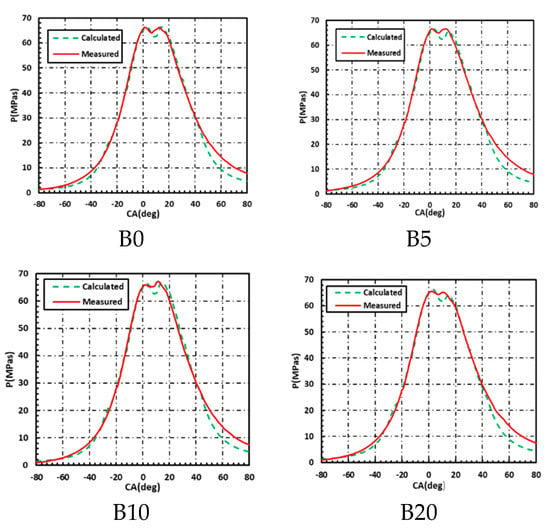
Figure 12.
Comparison of measured and calculated CP curves for all fuels at 1400 rpm and 100% load.
3.2.2. Simulation of Combustion and Emission Parameters by AVL FIRE
Detailed simulations of combustion were made to investigate how the progress in temperature, emissions and combustion reaction for B0, B5, B10 and B20 at 1400 rpm and 100% load was achieved. Due to the fact that the maximum values of these parameters occur at different degrees of crankshaft rotation, for simulation, different angles were considered to show greater distinction among them. For the combustion reaction, the simulation for all fuels is shown in Figure 13 working at 373 CA in this case. As can be seen, the spherical combustion chamber contributes to the formation of the rotational current in the combustion chamber, thereby leading to a better air/fuel mixture in the cylinder and causing a higher engine efficiency. This simulation is for the same engine design as the one in Figure 2a. The images of the progress simulations of the combustion reaction indicate that there are differences in combustion reactions between B10 and other fuels. B10 has the smallest blue part and biggest rotational current in the combustion chamber which results in a better engine performance efficiency and the lower amount of CO production [45] (see Figure 10b). How to move the reaction of combustion throughout the cylinder is shown by the reaction progress variable simulation.
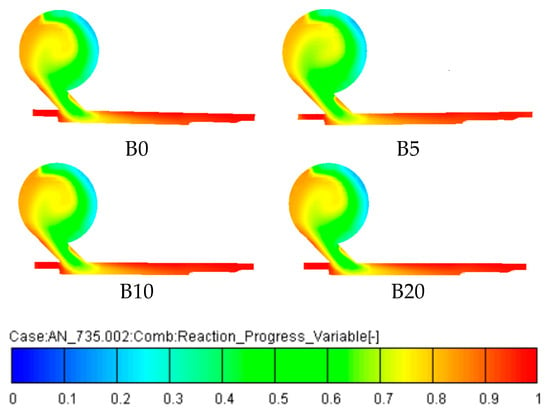
Figure 13.
Reaction_Progress_Variable at 13° After Top Dead Centre (ATDC) at 1400 rpm and 100% load.
The temperature progressions of the inside of the combustion chamber at 375 CA are shown in Figure 14. When the piston moves and combustion occurs, changes in temperature can be tracked using these images. The highest temperature was found for B10 at about 2382 K followed by B20 at around 2176 K. The smallest temperature peak occurred for B0 at around 1764–2176 K. In addition, the combustion temperature outside of the main spray area for B10 was higher than that of B5 and B0. These simulation results are in comprehensive agreement with experimental results (Figure 7b). When the temperature inside the combustion chamber increases, NOx production increases [58]. Therefore, the lower the combustion temperature, the lower the NOx emissions formation, and this finding is close in accordance with the published literature [59].
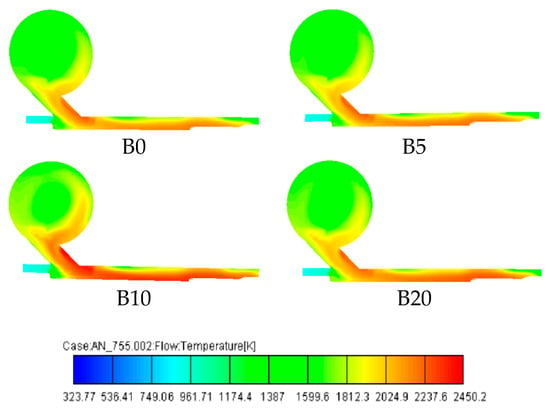
Figure 14.
The progress of in-cylinder temperature (K) at 15° ATDC at 1400 rpm and 100% load.
Figure 15’s images show the emissions of NOx mass fractions at 369 CA. The images reveal that B0 produces a smallest amount of NOx, which is around 27 − 36 × 10−5 ppm. Moreover, B10 has the largest amount of NOx production at about 36 − 45 × 10−5 ppm. However, the B10 quantity is in the middle range, not at the risk (red) range. These findings confirm the experimental results in Figure 8b. An interesting point in these images is the location of production of the highest NOx, which is in the throat of the spherical combustion chamber to the top of the piston. The reason is that, as Figure 14 indicates, the maximum temperature occurs at this location and, since the temperature rises, the amount of NOx increases, resulting in the highest amount of NOx being produced in that location. These images can help to determine when and where the NOx emissions are produced, along with the amount which can be compared among different fuel types to further confirm the findings.
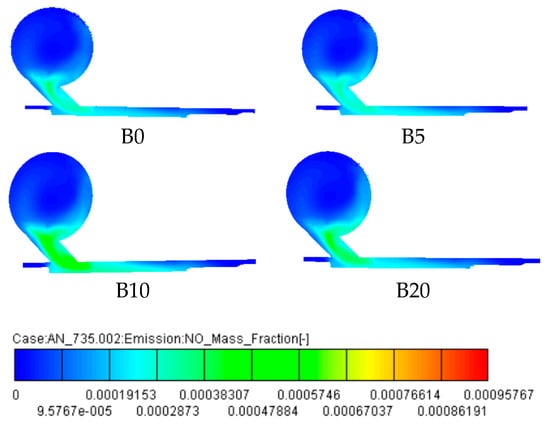
Figure 15.
The progress of NOx at 9° ATDC at 1400 rpm and 100% load.
Figure 16 shows the images of CO2 emissions as mass fractions at 390 CA. This figure shows how carbon dioxide is formed and its density distribution in the combustion chamber. The fraction of CO2 within the combustion chamber can be seen at each stage of the piston cycle. As can be observed, the largest and smallest amounts of CO2 are formed by B0 and B5, respectively. An interesting point is that the locations of CO2 formation are close to the boundaries of the combustion chamber since the remaining heat from the previous combustion cycles causes the temperature to rise further in the combustion chamber wall [60]. If these images are compared with Figure 14, the location of CO2 formation can be determined in a consistent manner by knowing the temperature pattern in the combustion chamber. Increasing the temperature facilitates the reaction between CO and oxygen. As a result, more CO2 is produced. In other words, the greater increasement in the gas temperature, the more complete combustion. In addition, if the engine speed increases, the production of carbon dioxide increases [60].
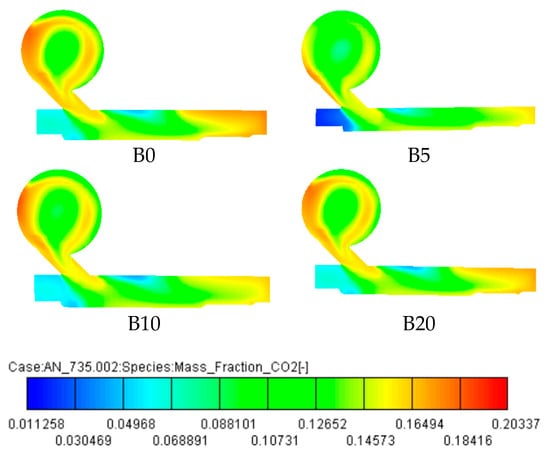
Figure 16.
The progress of CO2 at 30° ATDC at 1400 rpm and 100% load.
The images of CO emissions as mass fractions at 399 CA are displayed in Figure 17. Simulation results in these images confirm the experimental results in Figure 10b. As can be seen, the largest and smallest amounts of CO are related to B0 and B10, respectively. Compared with Figure 16, the location pattern of CO production is opposite to that of CO2. In many studies, the production of CO2 in the engine reportedly arose from the reaction of CO with oxygen in the vicinity of heat [60]. Therefore, a logical conclusion is that the CO concentration has an inverse relationship with the CO2 concentration in the combustion chamber. The second important observation is that the location of CO2 formation in the spherical combustion chamber is close to the boundaries of the piston, whereas CO is produced in the center area and at the top of the piston. However, the temperature of the combustion chamber wall at the top of the piston is very high due to the heating of previous combustion cycles, while the temperature of the spherical chamber wall is lower since it is located in the cylinder head and far from the heat center. Moreover, a cooling system of water circulates continuously around the spherical chamber wall. As mentioned earlier, heat is an important factor in converting CO to CO2, since a lower temperature reduces the kinetic energy and results in fewer collisions between molecules of CO and O2 gas, thereby slowing down the oxidation of CO to CO2 [60].
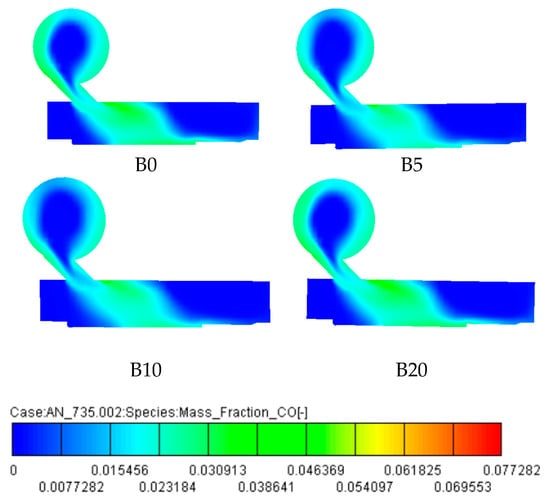
Figure 17.
The progress of CO at 39° ATDC at 1400 rpm and 100% load.
The images of PM emissions as mass fractions at 493 CA are displayed in Figure 18. From these images, it is found that the amounts of PM for all fuels are in a similar range, which is validated by the experimental results in Figure 11b. These images show that PM emissions are formed in the spherical combustion chamber from where the fuel is injected. The air–fuel ratio in the region near the injector is reduced which results in the production of PM, mainly due to a decrease in the air–fuel ratio when the fuel is injected into the combustion chamber [61].
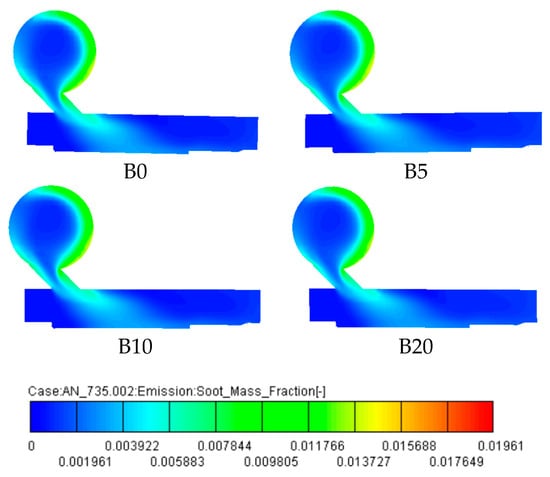
Figure 18.
The progress of PM at 39° ATDC at 1400 rpm and 100% load.
3.3. Conclusions
Nearly one-third of the world’s fossil fuels, which are one of the main air pollution sources, are used in internal combustion engines. Biodiesel is a domestically produced, clean-burning, renewable substitute for petroleum diesel. Tomato seed could be an excellent source of second-generation biodiesel production. In addition, the dimensions and shape of the combustion chamber have a direct impact on the quality of combustion as well as the production of engine pollutants, which was examined by simulation. The data of engine performance and emissions formation process were experimentally measured. Then, to investigate the performance and parameters involved in the emissions process, an engine combustion model was developed using the CFD in the AVL FIRE software. These simulations illustrated that, under standard conditions, the B20 mixed fuel produced the highest torque at about 158 NM in the engine. The BSFC reached a staggering 725 at 1400 rpm and 100% load. The best fuel, if the aim is to reduce emissions, is that for which the amounts of NOx, CO2, PM emissions and the value of EGT reach their lowest values. In fact, the amount of CO production becomes very little when B5 is used as the fuel. Moreover, the simulation of emissions indicated that using the B10 fuel leads to the highest amount of NOx production into the throat. One of the excellent features of the AVL FIRE software is that it can be generalized to a wide range of engine operating conditions, which means that the results of other non-tested engine conditions can be easily predicted. This special feature of this software makes it a great tool for solving engine engineering problems, especially under performance and emissions themes. Since one of the benefits of developed software simulations is the identification of heat zones in the combustion chamber, which have a direct impact on the production of engine pollutants, the production of pollutants can be greatly reduced by cooling the hot zones. However, the question is over how it is possible for special areas of the combustion chamber to be cooled more, which needs more research.
Author Contributions
The contributions of each author are as follows: R.K. drafted the manuscript; M.G.R. contributed to the experimental design and thoroughly revised the paper; M.M.K.K. helped to revise and improve the paper. All authors have read and agreed to the published version of the manuscript.
Funding
This research received no external funding
Conflicts of Interest
The authors declare no conflict of interest.
Nomenclature
| D | Diesel |
| BD | Biodiesel |
| B0 | 0% Biodiesel+ 100% Diesel |
| B5 | 5% Biodiesel+ 95% Diesel |
| B10 | 10% Biodiesel+ 90% Diesel |
| B20 | 20% Biodiesel+ 80% Diesel |
| TSOB | Tomato Seed Oil Biodiesel |
| L | Load |
| S | Speed of Engine |
| K | Kelvin |
| TAN | Total Acid Number |
| CI | Compression Ignited |
| CA | Crank Angle |
| IDI | Indirect Injection |
| rpm | Revolutions per minute |
| ANOVA | Analysis of Variance |
| TDC | Top Dead Centre |
| ATDC | After Top Dead Centre |
| BDC | Bottom Dead Centre |
| BTDC | Before Top Dead Centre |
| ESE | Engine Simulation Environment |
| HC | Hydrocarbon |
| CP | Cylinder Pressure |
| EGT | Exhaust Gas Temperature |
| PM | Particulate matter |
| LHV | Lower Heating Value |
| SPSS | Statistical Package for the Social Sciences |
| CFD | Computational fluid dynamics |
| ANN | Artificial Neural Networks |
| ASTM | American Society for Testing and Materials |
| BSFC | Brake Specific Fuel Consumption |
| E-TVCS | Engine-Three Vortex Combustion System |
References
- Aldhaidhawi, M.; Chiriac, R.; Badescu, V.; Alfaryjat, A.A. Numerical Investigation on the Combustion Characteristics a Diesel Engine Fuelled Biodiesel B20. 2017. Available online: http://www.agir.ro/buletine/2858.pdf (accessed on 17 July 2020).
- Van Gerpen, J. Biodiesel Processing and Production. Fuel Process. Technol. 2005, 86, 1097–1107. [Google Scholar] [CrossRef]
- Boot, M.; Frijters, P.; Luijten, C.; Somers, B.; Baert, R.; Donkerbroek, A.; Klein-Douwel, R.; Dam, N. Cyclic Oxygenates: A new class of second-generation biofuels for diesel engines. Energy Fuels 2009, 23, 1808–1817. [Google Scholar] [CrossRef]
- Wang, Y.; Ou, S.; Liu, P.; Zhang, Z. Preparation of Biodiesel from Waste Cooking Oil via Two-step Catalyzed Process. Energy Convers. Manag. 2007, 48, 184–188. [Google Scholar] [CrossRef]
- Knothe, G. Dependence of Biodiesel Fuel Properties on the Structure of Fatty Acid Alkyl Esters. Fuel Process. Technol. 2005, 86, 1059–1070. [Google Scholar] [CrossRef]
- Karami, R.; Kamgar, S.; Karparvarfard, S.H.; Rasul, M.G.; Khan, M.M.K. Biodiesel production from tomato seed and its engine emission test and simulation using Artificial Neural Network. J. Oil Gas Petrochem. Technol. 2018, 1, 41–62. [Google Scholar] [CrossRef]
- Giuffrè, A.M.; Sicari, V.; Capocasale, M.; Zappia, C.; Pellicanò, T.M.; Poiana, M. Physico-chemical properties of tomato seed oil (Solanum lycopersicum L.) for biodiesel production. Acta Hort. 2015, 1081, 237–244. [Google Scholar] [CrossRef]
- Giuffrè, A.M.; Sicari, V.; Capocasale, M.; Zappia, C.; Pellicanò, T.M.; Poiana, M. Physico-chemical composition of tomato seed oil for an edible use: The effect of cultivar. Int. Food Res. J. 2016, 23, 583–591. [Google Scholar]
- Globenewswire. News-Release, Global-Tomato. 2019. Available online: https://www.globaltomatocongress.com/programme (accessed on 17 July 2020).
- Tomato News. The Global Tomato Processing Industry. 2018. Available online: http://www.tomatonews.com/en/background_47.html (accessed on 18 April 2020).
- Al-Betawi, N.A. Preliminary study on tomato pomace as unusual feedstuff in broiler diets. Pak. J. Nutr. 2005, 4, 57–63. [Google Scholar] [CrossRef]
- Knoblich, M.; Anderson, B.; Latshaw, D. Analyses of tomato peel and seed byproducts and their use as a source of carotenoids. Sci. Food Agric. 2005, 85, 1166–1170. [Google Scholar] [CrossRef]
- Harish, S.; Vivek, S.; Shri, K.R.; Sudharsan, R.S.; Saravana, K.N. Investigation of biodiesel obtained from tomato seed as a potential fuel alternative in a CI engine. Biofuels 2017, 10, 7269–7277. [Google Scholar] [CrossRef]
- Karami, R.; Rasul, M.G.; Khan, M.M.K.; Anwar, M. Performance Analysis of Direct Injection Diesel Engine Fueled with Diesel-Tomato Seed Oil Biodiesel Blending by ANOVA and ANN. Energies 2019, 12, 4421. [Google Scholar] [CrossRef]
- Jafarmadar, S.; Khalilarya, S.H.; Shafee, S.; Barzegar, R. Modeling the Effect of Spray/Wall Impingement on Combustion Process and Emission in a D.I. Diesel Engine. Therm. Sci. Int. Sci. J. 2009, 13, 23–33. [Google Scholar] [CrossRef]
- Jafarmadar, S.; Shafee, S.; Barzegar, R. Numerical Investigation of the Effect of Fuel Injection Mode on Spray-Wall Impingement and Combustion Process in a Direct Injection Diesel Engine at full load state. Therm. Sci. Int. Sci. J. 2010, 14, 1039–1049. [Google Scholar] [CrossRef]
- Barzegar, R.; Shafee, S.; Khalilarya, S. CFD Simulation of the Combustion Process, Emission Formation and the Flow Field in an In-Direct Injection Diesel Engine. Therm. Sci. 2013, 1, 1–16. [Google Scholar] [CrossRef]
- Harch, C.A.; Rasul, M.G.; Hassan, N.M.S.; Bhuiya, M.M.K. Modelling of Engine PerformanceFuelled with Second Generation Biodiesel. Procedia Eng. 2014, 90, 459–465. [Google Scholar] [CrossRef]
- Heywood, J.B. Internal Combustion Engine Fundamental; McGraw Hill: New York, NY, USA, 1988. [Google Scholar]
- Benson, R.S.; Whitehouse, N.D. Internal Combustion Engines: A Detailed Introduction to the Thermodynamics of Spark and Compression Ignition Engines, Their Design and Development; Pergamon Press: Oxford, UK, 1979; Available online: https://lib.ugent.be/catalog/rug01:000211175 (accessed on 18 April 2020).
- Obert, E.F. Internal Combustion Engines and Air Pollution; Text Education Publ.: New York, NY, USA, 1993. [Google Scholar]
- Uludogan, A.; Foster, D.E.; Reitz, R.D. Modelling the effect of engine speed on the combustion process and emissions in a DI Diesel engine. SAE Tech. Pap. 1996, 962056. [Google Scholar] [CrossRef]
- Tata, M.E.; Jon, H.; Gerpena, V.; Soylua, S.; Canakcia, M.A.M.; Wormleyb, S. The Speed of Sound and Isentropic Bulk Modulus of Biodiesel at 21 °C from Atmospheric Pressure to 35. J. Am. Oil Chem. Soc. 2000. [Google Scholar] [CrossRef]
- Hassan, N.M.S.; Rasul, M.G.; Harch, C.A. Modelling and experimental investigation of engine performance and emissions fuelled with biodiesel produced from Australian Beauty Leaf Tree. Fuel 2015, 150, 625–635. [Google Scholar] [CrossRef]
- DieselEngineMotor. 2019. Available online: http://www.dieselenginemotor.com/kubota/v3300/page1.html (accessed on 16 April 2020).
- AVL List. AVL FIRE User Guide, Version 2011; AVL List GmbH: Graz, Austria, 2012. [Google Scholar]
- Hanjalic, K.; Popovac, M.; Hadziabdic, M. A robust near-wall elliptic relaxation eddy-viscosity turbulence model for CFD. Int. J. Heat Fluid Flow 2004, 25, 1047–1051. [Google Scholar] [CrossRef]
- Bari, S. Diesel Engine: Combustion, Emissions and Condition Monitoring; Automobile Engineering; Intech Open Access Publisher: London, UK, 2013; ISBN 978-953-51-1120-7. [Google Scholar] [CrossRef]
- WSM V3300. Workshop Manual Diesel Engine V3300-E2b/V3300-T-E2b; WSM: Christchurch, New Zealand, 2014. [Google Scholar]
- Hosseini, S.H.; Taghizadeh-Alisaraei, A.; Ghobadian, B.; Abbaszadeh-Mayvan, A. Effect of added alumina as Nano-catalyst to diesel-biodiesel blends on performance and emission characteristics of CI engine. Energy 2017, 124, 543–552. [Google Scholar] [CrossRef]
- Heydari-Maleney, K.; Taghizadeh-Alisaraei, A.; Ghobadian, B.; Abbaszadeh-Mayvan, A. Analyzing and evaluation of carbon nanotubes additives to diesohol-B2 fuels on performance and emission of diesel engines. Fuel 2017, 196, 110–123. [Google Scholar] [CrossRef]
- Aydin, H.; Bayindir, H. Performance and emission analysis of cottonseed oil methyl ester in a diesel engine. Renew. Energy 2010, 35, 588–592. [Google Scholar] [CrossRef]
- Song, J.T.; Zhang, C.H. An experimental study on the performance and exhaust emissions of a diesel engine fueled with soybean oil methyl ester. Proc. Inst. Mech. Eng. Part D J. Automob. Eng. 2008, 222, 2487–2496. [Google Scholar] [CrossRef]
- Lin, B.; Huang, J.; Huang, D. Experimental study of the effects of vegetable oil methyl ester onDI diesel engine performance characteristics and pollutant emissions. Fuel 2009, 88, 1779–1785. [Google Scholar] [CrossRef]
- Rahman, S.M.A.; Nabi, M.N.; Van, T.C.; Suara, K.; Jafari, M.; Dowell, A.; Islam, M.A.; Marchese, A.J.; Tryner, J.; Hossain, M.F.; et al. Performance and Combustion Characteristics Analysis of Multi-Cylinder CI Engine Using Essential Oil Blends. Energies 2018, 11, 738. [Google Scholar] [CrossRef]
- Saheed, S.A.; Olalekan, B.B. Load Performance of a Spark Ignition Engine Using Ethanol-Gasoline Blends as Alternative Fuel. Int. J. Adv. Eng. Technol. 2013, 6, 1932–1941. [Google Scholar]
- Najafi, B.; Torkian, M.; Hejazi, M.A.; Zamzamian, A.A. Effect of Microalgae Biodiesel on Performance Parameters and Exhaust Emissions from IDI Diesel Engine. Fuel Combust. 2012, 4, 29–42. [Google Scholar]
- Utlu, Z.; Kocak, M.S. The effect of biodiesel fuel obtained from waste frying oil on direct injection diesel engine performance and exhaust emissions. Renew. Energy 2008, 33, 1936–1941. [Google Scholar] [CrossRef]
- Luján, J.M.; Bermúdez, V.; Tormos, B.; Pla, B. Comparative analysis of a DI diesel engine fuelled with biodiesel blends during the European MVEG-A cycle: Performance and emissions (II). Biomass Bioenergy 2009, 33, 948–956. [Google Scholar] [CrossRef]
- Labeckas, G.; Slavinskas, S. The effect of rapeseed oil methyl ester on direct injection diesel engine performance and exhaust emissions. Energy Convers. Manag. 2006, 47, 1954–1967. [Google Scholar] [CrossRef]
- Fontaras, G.; Karavalakis, G.; Kousoulidou, M.; Tzamkiozis, T.; Ntziachristos, L.; Bakeas, E.; Stournas, S.; Samaras, Z. Effects of biodiesel on passenger car fuel consumption, regulated and non-regulated pollutant emissions over legislated and real-world driving cycles. Fuel. 2009, 88, 1608–1617. [Google Scholar] [CrossRef]
- Curto, J.W.; Giambrone, M.D.; MacGrogan, A.S.; Williamson, G.H. A Comparative Analysis of Biodiesel and Diesel Emissions. A Major Qualifying Project Report Submitted to the Faculty of the Worcester Polytechnic Institute. E-project-042815-163944. 2015. Available online: https://web.wpi.edu/Pubs/E-project/Available/E-project-042815-163944/unrestricted/Biodiesel_MQP_FINAL.pdf (accessed on 16 April 2020).
- Ozsezen, A.N.; Canakci, M.; Turkcan, A.; Sayin, C. Performance and combustion characteristics of a DI diesel engine fueled with waste palm oil and canola oil methyl esters. Fuel 2009, 88, 629–636. [Google Scholar] [CrossRef]
- Adam, I.K.; Aziz, A.; Rashid, A.; Heikal, M.R.; Yusup, S.; Ahmad, A.S.; Abidin, Z.; Zharif, E. Performance and Emission Analysis of Rubber Seed, Palm, and Their Combined Blend in a Multi-Cylinder Diesel Engine. Energies 2018, 11, 1522. [Google Scholar] [CrossRef]
- Ahmadipour, S.; Aghkhani, M.H.; Zareei, J. The effect of compression ratio and alternative fuels on performance and exhaust emission in a diesel engine by modelling engine. AUT J. Mech. Eng. 2019, 3. [Google Scholar] [CrossRef]
- Qi, D.H.; Geng, L.M.; Chen, H.; Bian, Y.Z.H.; Liu, J.; Ren, X.C.H. Combustion and performance evaluation of a diesel engine fueled with biodiesel produced from soybean crude oil. Renew. Energy 2009, 34, 2706–2713. [Google Scholar] [CrossRef]
- Lin, C.Y.; Li, R.J. Engine performance and emission characteristics of marine fish-oil biodiesel produced from the discarded parts of marine fish. Fuel Process Technol. 2009, 90, 883–888. [Google Scholar] [CrossRef]
- Xue, J.; Grift, T.; Hansen, A. Effect of Biodiesel on Engine Performances and Emissions. Renew. Sustain. Energy Rev. 2011, 15, 1098–1116. [Google Scholar] [CrossRef]
- Banapurmath, N.R.; Tewari, P.G.; Hosmath, R.S. Effect of biodiesel derived from Honge oil and its blends with diesel when directly injected at different injection pressures and injection timings in single-cylinder water-cooled compression ignition engine. Proc. Inst. of Mech. Eng. Part A J. Power Energy 2009, 223, 31–40. [Google Scholar] [CrossRef]
- Sahoo, P.K.; Das, L.M.; Babu, M.K.G.; Arora, P.; Singh, V.P.; Kumar, N.R.; Varyani, T.S. Comparative evaluation of performance and emission characteristics of jatropha, karanja and polanga based biodiesel as fuel in a tractor engine. Fuel 2009, 88, 1698–1707. [Google Scholar] [CrossRef]
- Karavalakis, G.; Stournas, S.; Bakeas, E. Light vehicle regulated and unregulated emissions from different biodiesels. Sci. Total Environ. 2009, 407, 3338–3346. [Google Scholar] [CrossRef]
- Baiju, B.; Naik, M.K.; Das, L.M. A comparative evaluation of compression ignition engine characteristics using methyl and ethyl esters of Karanja oil. Renew. Energy 2009, 34, 1616–1621. [Google Scholar] [CrossRef]
- Rente, T.; Gjirja, S.; Denbratt, I. Experimental Investigation of the Effect of Needle Opening (NOP) Pressure on Combustion and Emissions Formation in a Heavy Duty DI Diesel Engine. J. Fuels Lubr. 2004, 113, 1692–1711. [Google Scholar]
- Kim, H.Y.; Ge, J.C.; Choi, N.J. Application of Palm Oil Biodiesel Blends under Idle Operating Conditions in a Common-Rail Direct-Injection Diesel Engine. Appl. Sci. 2018, 8, 2665. [Google Scholar] [CrossRef]
- Mobasheri, R.; Seddiq, M. Applying The Homogeneity Factor to Evaluate the Effects of Pilot Injection Characteristics On Air-Fuel Mixing Quality and Engine Performance in a Turbo-Charged High Speed Direct Injection (Hsdi) Diesel Engine. Fuel Combust. 2017, 10, 53–71. [Google Scholar]
- Ding, C.W.; Liu, W.J. Numerical Simulation of Emission Characteristics for Single-Cylinder Diesel Engine. Energy Power Eng. 2016, 8, 92–98. [Google Scholar] [CrossRef][Green Version]
- Mirmohammadi, A.; Ghadiri, M.; Aghamirsalim, A.M. Fuel Injection Pressure and Duration Effects On Passenger Diesel Engine Performance and Emissions. Iran. J. Mech. Eng. 2017, 18, 96–114. [Google Scholar]
- Yogish, H.; Chandrashekara, K.; Sharma, P.R. Analysis of the Relationship between Exhaust Gas Temperature (EGT in °C) and Nitrogen oxides (NOx in ppm) during Performance and Emission tests on various Biodiesels derived from edible and non-edible oils and their blends. Int. J. Therm. Technol. 2014, 4, 79–82. [Google Scholar]
- Tat, M.E.; Van Gerpen, J.H.; Wang, P.S. Fuel property effects on injection timing, ignition timing and oxides of nitrogen emissions from biodiesel-fueled engines. In Proceedings of the ASAE/CSAE Annual International Meeting, Ottawa, ON, Canada, 1–4 August 2004. [Google Scholar] [CrossRef]
- Muharam, Y.; Mahendra, M.; Giffari, F.; Kartohardjono, S. Effects of Injection Temperature and Pressure on Combustion in an Existing Otto Engine Using CNG Fuel. Environ. Sci. Technol. 2015, 8, 25–34. [Google Scholar] [CrossRef][Green Version]
- Raheman, H.; Ghadge, S.V. Performance of compression ignition engine with mahua (Madhuca indica) biodiesel. Fuel 2007, 86, 2568–2573. [Google Scholar] [CrossRef]
© 2020 by the authors. Licensee MDPI, Basel, Switzerland. This article is an open access article distributed under the terms and conditions of the Creative Commons Attribution (CC BY) license (http://creativecommons.org/licenses/by/4.0/).